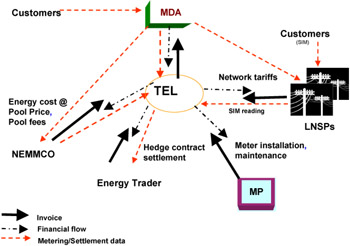Complexity in New Information Systems Development
|
|
The management of TEL must first realize the complexity and limitations of their IT infrastructure, before they venture into the new business. TEL follows a standard procedure called Product Development Operational Model (PDOM) for any IT product development and this procedure was also applied in developing its IT architecture design. PDOM is very similar to standard Systems Development Life Cycle (SDLC) (Kendall & Kendall, 1995).
Figure 4 shows the relationship between TEL and the third parties that it must reconcile.

Figure 4: Relationships Between TEL and Third Parties
Reconciliation with these third parties is critical to ensure the following items are accurate for customers: charges, dates (i.e., customer's start and end dates), rates, services received, usage and loss factors. Reconciliation is also necessary to ensure that payments are settled for the correct dollar amount, and are on time. The third parties with whom TEL will be required to settle with are National Electricity Market Management Company (NEMMCO), Local Network Service Providers (LNSPs), MDAs, MPs, Energy Traders, and other retailers.
For the proposed alliance to become effective, TEL will be required to develop a number of third party relations with electricity retailers. These relationships are shown in Table 2 below.
| Retailers | Relationships |
|---|---|
| Electricity Sourcing | TEL will need to contract energy traders to purchase electricity in the national electricity market. TEL will be required to settle periodically with these organizations for services rendered. |
| NEMMCO | Tel will be required to settle periodically with National Electricity Market Management Company (NEMMCO) for wholesale electricity purchases. NEMMCO will provide billing reconciliation data. |
| MDA | TEL will contract with NEMMCO accredited MDAs for the collection and provision of customer electricity usage data for billing purposes. TEL will be required to settle periodically with MDAs for services rendered. |
| MP | TEL as an RP, will have a relationship with MPs in the provision and maintenance of meter installations and TEL will be required to settle periodically for services rendered. |
| LNSP | TEL will enter into service agreements with each Local Network Service Provider (LNSP) for the use of their distribution network and for the connection and supply of electricity. TEL will be required to settle periodically with LNSPs in terms of distribution fees for network use. |
| NEMMCO and State Regulators | TEL will pay fees to NEMMCO and state regulators for operating licenses and other regulatory charges. |
| Generators | TEL may contract with generators (outside of the spot market) for long term energy requirements. |
| TEL Partner sales commissions | TEL could potentially enter into sales partnerships and pay appropriate commissions. |
To forge a meaningful alliance, TEL would be required to make a number of major business decisions, which would influence their overall IT architecture. These decisions would form the core of the IT system and partnership relations and are presented in Table 3.
| Decision |
|---|
| TEL will require a customer signed application form before the Retail Transfer process can commence. |
| TEL will not enter into and conduct a customer transfer under the BETS process. |
| The company will negotiate contracts with a LNSP, which will ensure that LNSPs will connect customers to their network at a customer nominated date and time or within a reasonable time. Noteworthy each LNSP will perform service location work for the electricity connection. |
| TEL will appoint only registered to read meters at agreed customer start date and times. |
| An MP will install and remove electricity meters only with company's written instructions. |
| Each LNSP is responsible for fault rectification and maintenance of their electricity distribution network in their local area. TEL will hand off to the appropriate LNSP for fault calls made to TEL. TEL will pay the relevant service fee, but if the customer is culpable for the fault, the onus will be on the LNSP to recover costs. |
| MDAs are to provide all customer electricity usage to the Retailer for billing purposes, typically daily overnight for smart meters. MDAs will employ manual meter readers to read SIMs at a minimum interval of monthly regardless of the billing cycle. |
| TEL will settle with MDAs, LNSPs, MPs, energy traders and the Pool for electricity energy cost of goods sold. |
| TEL must provide energy forecasts to energy traders so they can determine the amount of energy to hedge. |
If these alliances are to eventuate, the existing processes and systems will be used to generate reports to partner sales and commissions. TEL would be required to provide a lot of technical support to potential strategic partners, since partners in the electricity retail business in general do not have well developed information systems. In fact, most electricity retailers had manual settlement systems. This would be a serious limitation to full-scale system integration.
|
|
EAN: 2147483647
Pages: 186